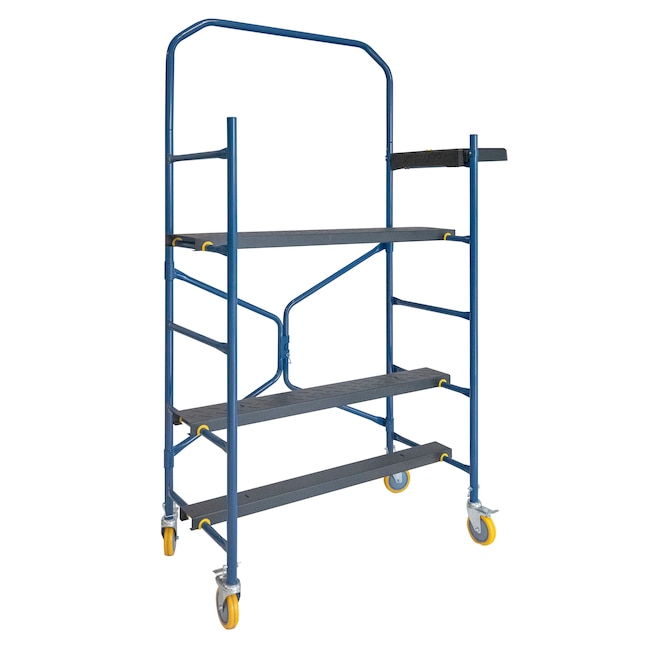Exploring the Numerous Kinds of Scaffolding Utilized in Building And Construction Projects
The construction sector counts heavily on numerous types of scaffolding to meet details task needs, each offering distinctive advantages and applications. Standard frame scaffolding gives a strong structure for general jobs, while suspended scaffolding is important for job on high-rise frameworks.

Standard Framework Scaffolding
Typical frame scaffolding is among the most widely utilized techniques in the building and construction sector as a result of its toughness and convenience. This system includes vertical and horizontal structures that are set up to produce a secure system for materials and employees. The major parts consist of vertical posts, straight ledgers, and angled braces, which together offer a solid framework that can support considerable loads.
Among the crucial advantages of standard frame scaffolding is its adaptability to numerous building tasks, ranging from domestic structures to large business frameworks. The modular style enables for simple assembly and disassembly, making it efficient for both long-term and short-term projects. Furthermore, the system can be tailored in height and size, fitting various building designs and website conditions.
Security is paramount in scaffolding applications, and standard frame systems are furnished with guardrails and toe boards to prevent falls and make sure employee security. In addition, regular evaluations and adherence to safety laws are essential in preserving the stability of the scaffold. Overall, conventional framework scaffolding stays an essential option in the building market, providing a trusted system for labor and boosting total job performance

Suspended Scaffolding
Suspended scaffolding supplies an one-of-a-kind remedy for building and construction jobs that require accessibility to elevated surface areas, especially in situations where standard framework scaffolding may be not practical. This type of scaffolding is usually suspended from the roofing system or top degrees of a framework, utilizing a system of ropes, platforms, and pulley-blocks to develop a working area that can be adapted to numerous elevations.
One of the main advantages of put on hold scaffolding is its versatility. It can be conveniently repositioned or decreased to suit adjustments in building demands, making it suitable for tasks such as window setup, frontage job, and maintenance on skyscrapers. In addition, the minimal impact of suspended scaffolding permits for better use of ground area in metropolitan environments, where area is usually restricted.
Security is a crucial factor to consider in the usage of put on hold scaffolding. Generally, suspended scaffolding supplies a effective and efficient solution for accessing hard-to-reach areas in numerous building and construction situations, boosting both performance and safety and security on website.
System Scaffolding
System scaffolding, typically considered as a modern-day remedy in the scaffolding market, includes pre-engineered components that can be swiftly constructed and adjusted for numerous construction projects. Scaffolding. This kind of scaffolding is identified by its modular design, which enables for flexibility and efficiency on work websites, description fitting structural requirements and various elevations
Commonly made from high-strength steel or light weight aluminum, original site system scaffolding uses enhanced resilience and security. The components consist of vertical posts, straight journals, and angled braces, which adjoin firmly, making sure a robust structure. The style typically integrates standard fittings, streamlining setting up and disassembly processes, therefore minimizing labor time and costs.

Rolling Scaffolding
Moving scaffolding is a functional choice to conventional set scaffolding, made for flexibility and convenience of usage on construction sites. This type of scaffolding includes a system supported by frameworks with wheels, enabling workers to easily relocate it as needed. The movement feature significantly enhances productivity, as it minimizes downtime related to dismantling and constructing taken care of scaffolding.
Normally built from lightweight materials such as aluminum or steel, rolling scaffolding uses a tough yet portable service for tasks calling for constant repositioning - Scaffolding. It is particularly useful in jobs such as painting, drywall installation, and electric work, where accessibility to various heights and places is required
Safety and security is vital in rolling scaffolding style, with features such as securing wheels to avoid unintended motion when in use, and guardrails to shield workers from drops. Furthermore, numerous versions are adjustable in elevation, accommodating various task requirements.
Cantilever Scaffolding

The layout of cantilever scaffolding normally entails making use of arms or brackets anchored to a building or framework, making it possible for the system to extend outward securely. Security is vital; therefore, these scaffolds must be engineered to hold up against ecological problems and different tons. Regular inspection and upkeep are vital to ensure architectural stability and worker safety and security.
Cantilever scaffolding is preferred for its convenience and effective use of room, making it a prominent selection in metropolitan environments where room restrictions prevail. Furthermore, it facilitates less complicated access to high altitudes, eventually adding to the total effectiveness of construction projects. Just like all scaffolding types, appropriate training and adherence to safety requirements are crucial for employees using cantilever scaffolding.
Verdict
Finally, the varied sorts of scaffolding made use of in building tasks each serve unique objectives tailored to details site needs. Conventional structure scaffolding provides stability, while put on hold scaffolding supplies flexibility for elevated jobs. System scaffolding facilitates quick setting up, and rolling scaffolding boosts wheelchair for varying workplace. Cantilever scaffolding properly addresses barriers in urban settings. Understanding these scaffolding types is crucial for enhancing safety and security and performance in construction, ultimately contributing to the effective conclusion of tasks.
Conventional frame scaffolding gives a tough structure for basic tasks, while suspended scaffolding is crucial for job on skyscraper frameworks.Rolling scaffolding is a flexible choice to typical set scaffolding, developed for movement and simplicity of usage on building sites. As with all scaffolding kinds, proper training and adherence to safety and security criteria are essential for employees making use of cantilever scaffolding.
Traditional structure scaffolding gives stability, while put on hold scaffolding supplies adaptability for elevated jobs. System scaffolding promotes quick assembly, and rolling scaffolding boosts movement for varying job atmospheres.